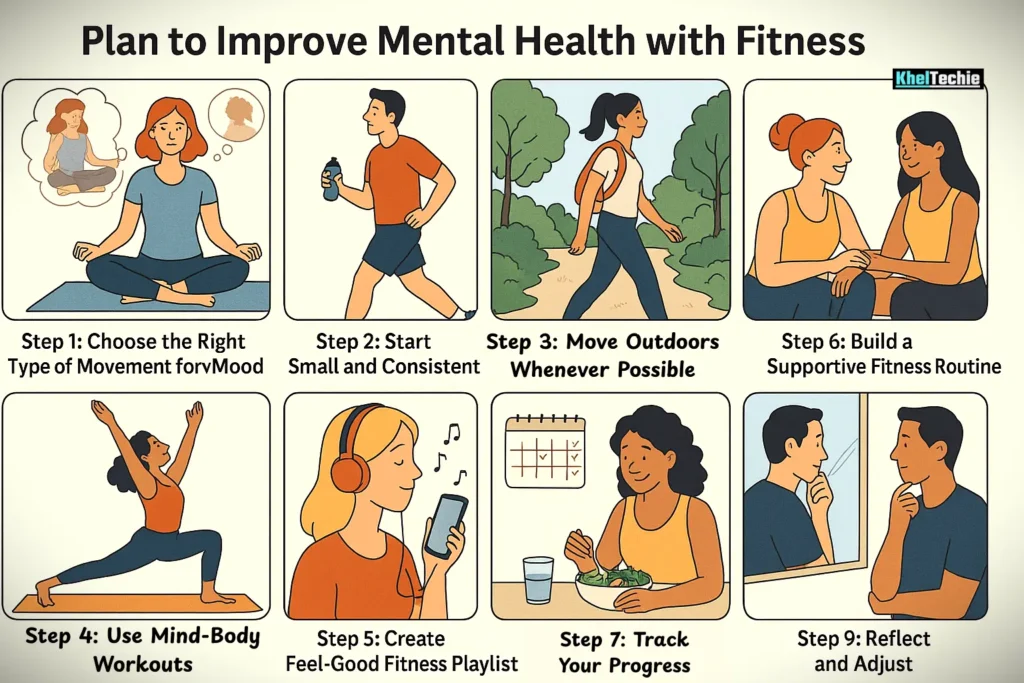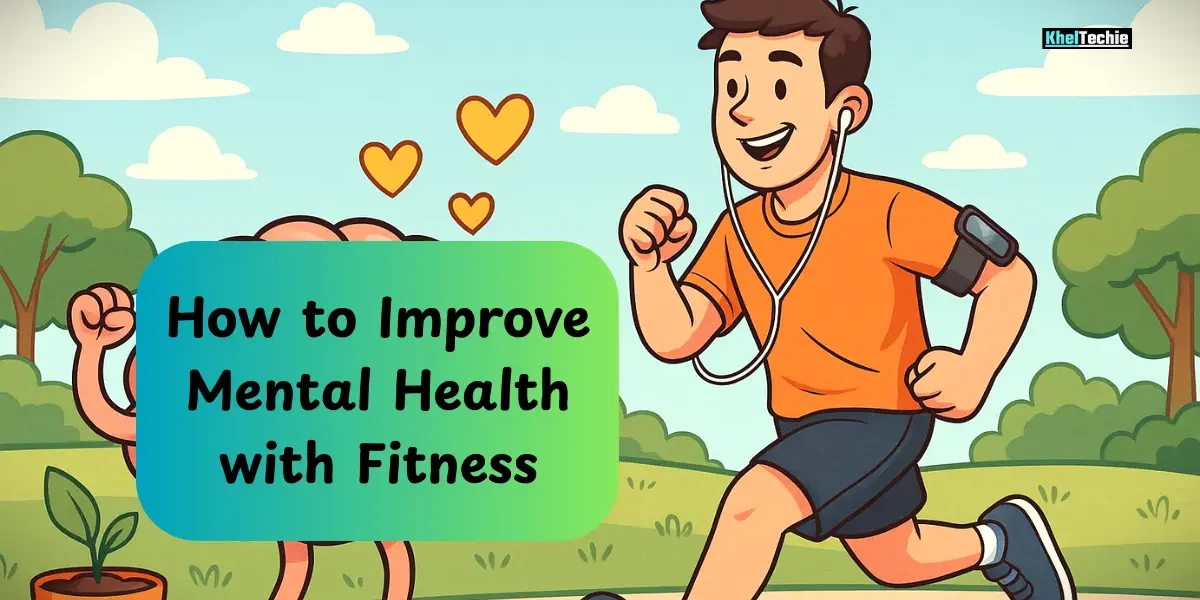How to Improve Mental Health with Fitness: A Life-Changing Guide
Feeling Mentally Exhausted? You’re Not Alone!
You’ve probably felt it before, the weight of stress after a long day, anxiety creeping in at night, or just that foggy feeling where nothing seems right. And maybe you’ve tried everything: meditation apps, therapy sessions, even changing your diet. But what if the solution was simpler than you thought?
How to improve mental health with fitness isn’t just another buzzword. It’s a scientifically backed, deeply personal journey that millions have used to reclaim their peace of mind. Whether you’re dealing with mild stress or more serious mental health concerns, movement might be the missing piece.
Let’s break this down together, no jargon, no fluff, just real talk and actionable steps.

What Is Improving Mental Health with Fitness?
Improving mental health with fitness means using physical activity intentionally to boost emotional well-being. It’s not about punishing workouts. It’s about moving in ways that make you feel calm, connected, and capable.
Think of your brain like a garden. Without proper care, sunlight, water, and tending, it becomes overgrown with weeds (anxiety, depression, fatigue). Exercise is the gardener who helps clear the clutter and plant something beautiful.
Why Improving Mental Health with Fitness Matters
Mental health issues are rising globally. According to the World Health Organization, over 280 million people worldwide suffer from depression. But regular physical activity can reduce depression risk by up to 26%.
Here’s why fitness works wonders for your mind:
✅ Boosts “Feel-Good” Chemicals
- Endorphins: Reduce pain, stress, and anxiety.
- Serotonin & Dopamine: Improve mood and motivation.
- BDNF: Encourages brain cell growth and emotional regulation.
✅ Regulates Sleep & Circadian Rhythm
Poor sleep = poor mental health. Exercise helps reset your internal clock and improves deep sleep cycles.
✅ Builds Self-Esteem & Body Confidence
You don’t need to lose weight to feel good, showing up for yourself builds emotional self-trust.
✅ Disrupts Negative Thought Loops
Focused movement, like yoga or running, pulls you out of anxious spirals and into the present moment.
Real Talk: I remember my first panic attack. I was 26, overwhelmed with work, and had barely left my couch in weeks. The turning point? Signing up for a beginner yoga class. Within a month, I slept better, laughed more, and actually looked forward to waking up.

Plan to Improve Mental Health with Fitness
Let’s break this down into an easy-to-follow blueprint. These aren’t just workouts, they’re mental fitness rituals.
Step 1: Choose the Right Type of Movement for Your Mood
| Mood | Best Exercise Type | Why It Works |
|---|---|---|
| Stressed | Yoga or Tai Chi | Calms nervous system |
| Depressed | Brisk Walking | Elevates endorphins, easy to start |
| Anxious | HIIT or Cardio | Burns excess adrenaline |
| Sad | Dance | Releases serotonin and joy hormones |
| Tired | Stretching or Light Yoga | Low-intensity, recharges energy |
Step 2: Start Small and Consistent
Don’t aim for 1-hour workouts. Start with 10–20 minutes, 3–5 days a week. The goal is consistency, not intensity.
- ✅ Use habit stacking: Tie fitness to an existing habit (e.g., “After coffee, I’ll do 10 squats.”)
- ✅ Track your mood pre- and post-workout in a journal or app.
Step 3: Move Outdoors Whenever Possible
Research from Harvard shows “green exercise” (working out in nature) significantly reduces cortisol (stress hormone).
- Try a walk in the park, beach yoga, or outdoor cycling.
- Natural light helps boost Vitamin D, linked to better mood.
Step 4: Use Mind-Body Workouts
Add one mindful workout per week:
- Yoga
- Pilates
- Breathwork & mobility
- Guided walking meditations (try Headspace or Insight Timer)
These calm your fight-or-flight response and shift you into a more relaxed, focused state.
Step 5: Create a Feel-Good Fitness Playlist
Music activates reward centers in the brain and makes exercise more enjoyable.
- Build playlists based on your mood.
- Add uplifting, nostalgic, or empowering songs.
Step 6: Build a Supportive Fitness Routine
You’re more likely to stick with fitness when:
- You work out with a friend
- You join a supportive community (like a local class or online challenge)
- You set “process” goals, like “move 20 minutes daily,” instead of aesthetic goals
Step 7: Track Your Progress
Use a journal or app to log your workouts and how you feel afterward. Over time, you’ll notice patterns.
📊 Example:
| Date | Activity | Mood Before | Mood After |
|---|---|---|---|
| May 5 | 20-min walk | Anxious | Calm |
| May 7 | Yoga session | Tired | Energized |
Step 8: Combine with Other Healthy Habits
Exercise works best when paired with good nutrition, hydration, and quality sleep.
💡 Quick Combo: Post-workout smoothie + 7 hours of sleep = mental reset.
Step 9: Reflect and Adjust
Every Sunday, ask yourself:
- What made me feel better this week?
- What type of movement boosted my mood?
- What can I change or simplify next week?
Common Mistakes to Avoid
Avoid these pitfalls to stay on track and maximize benefits.
❌ 1. Overtraining Too Soon
Jumping into intense workouts can lead to burnout or injury. Start slow and build gradually.
❌ 2. Comparing Yourself to Others
Your journey is yours alone. Focus on your growth, not someone else’s highlight reel.
❌ 3. Ignoring Mental Cues
Pushing through pain is admirable, but ignoring emotional exhaustion can backfire. Rest is part of the process.
❌ 4. Relying Only on Fitness
While powerful, exercise isn’t a magic pill. Combine it with professional support if needed.
❌ 5. Forgetting to Have Fun
If you dread your workouts, you won’t stick with them. Find joy in movement.
❌ 6. Ignoring Nutrition
Fitness without proper fuel affects your mental clarity and energy. Prioritize hydration, whole foods, and omega-3s
Final Thoughts: Ready to Recharge Your Mind with Movement?
Improving your mental health with fitness isn’t about being perfect, it’s about creating tiny wins that add up to lasting well-being.
Whether you’re battling anxiety, low mood, or just need more energy, moving your body is the simplest, most natural medicine you already have access to.
So here’s your gentle push: pick one tip from this guide and try it today.
Let your body be the bridge to your better self.
💬 Have questions or your own story to share? Drop a comment below, I’d love to hear how fitness has helped your mental health.
FAQs
What are the best exercises for mental health?
Brisk walking, yoga, strength training, and aerobic workouts have the strongest scientific backing for improving mood, focus, and sleep.
Should I consult a doctor before starting?
If you have chronic health conditions, severe mental illness, or haven’t been active recently, yes. A healthcare provider can guide you safely.
How long does it take to see mental health benefits from fitness?
You can feel better immediately after a single session, but consistent improvements often show up in 2–4 weeks.
Is it better to work out in the morning or evening for mental health?
Morning workouts help regulate sleep and mood, but the best time is when you’ll stick with it.
Can fitness replace therapy or medication?
No. Fitness is a powerful supplement, but not a substitute. Always consult a licensed mental health professional.
Can too much exercise worsen mental health?
Yes. Over-exercising can cause burnout, anxiety, or hormonal imbalances. Rest is just as important as movement.
How does strength training help mental health?
Lifting weights improves self-esteem, releases dopamine, and teaches emotional discipline through structured routines.
Are there apps that combine fitness and mental health?
Yes! Try:
Balance by Gaiam
Nike Training Club (mind-body programs)
Headspace Move
Centr
What if I’m too depressed to work out?
Start tiny — even standing up and stretching for 2 minutes counts. Pair movement with something comforting, like your favorite music.
Can I still benefit if I work out just once or twice a week?
Absolutely. Even 1 session per week improves sleep, mood, and energy. Some movement is always better than none.
Does exercise help with anxiety?
Yes. Cardio and HIIT workouts help burn off adrenaline and calm your nervous system. Mindful movement like yoga also eases anxiety.





Pingback: Benefits Of Hiking For Physical And Mental Health - Nature
Pingback: Top 10 Best Healthy Desserts For Fitness Enthusiasts
Pingback: How To Build A Sustainable Meditation Habit
Pingback: How To Train Your Brain: 7 Mental Toughness Techniques